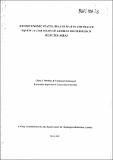| dc.contributor.author | Jesuit Centre for Theological Reflection | |
| dc.date.accessioned | 2023-05-16T10:23:08Z | |
| dc.date.available | 2023-05-16T10:23:08Z | |
| dc.date.issued | 2003-03-30 | |
| dc.identifier.uri | https://hdl.handle.net/20.500.14274/1791 | |
| dc.description | One of the fundamental aims of policy is to reduce poverty and inequality. Within the wide array of reforms instituted by the Zambian Government over the past decade, health reforms constitute a prominent component. The express objective of the health reforms is to provide to all Zambians equitable access to cost-effective and quality health care as close to the family as possible. | en |
| dc.description.abstract | In the 2001 economic report, the government does indicate that even though the delivery of basic health care services has slightly improved, the disease burden has worsened. The incidence rates for malaria, HIV/AIDS, and TB for instance have worsened between 1999 and 2001. The incidence rate for malaria increased by 2%, while those for HIV/AIDS and TB increased by 8% and 19% respectively. Admittedly, there have been some improvements in some areas. Improvements have been recorded in, among others, health expenditures per capita, number of drug kits, and health center staff loads. | en |
| dc.description.sponsorship | Irish Aid and Joint Country Programme | en |
| dc.language.iso | en | en |
| dc.publisher | Jesuit Centre for Theological Reflection | en |
| dc.rights | Attribution-ShareAlike 3.0 United States | * |
| dc.rights.uri | http://creativecommons.org/licenses/by-sa/3.0/us/ | * |
| dc.subject | March 2003 | en |
| dc.subject | Case Study | en |
| dc.subject | Socio-Economic | en |
| dc.title | March 2003 Socioeconomic Status, Health Status and Health Equity: A Case Study of Zambian Households in Selected Areas | en |
| dc.type | Case Study | en |

